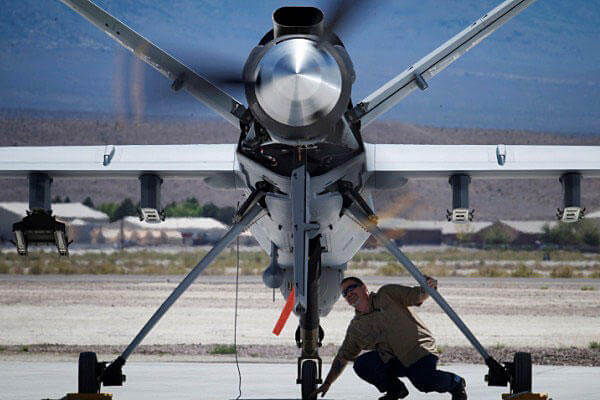Air Force officials cited the growing demands drone combat and reconnaissance missions and a lack of air controllers on the ground in Iraq and Syria as factors in the shortage of pilots for the remotely piloted aircraft (RPAs).
The Air Force was continuing "to meet the growing needs of warfighting combatant commanders" in Iraq, Syria and elsewhere while struggling to build a "right-sized capability" to balance the number of missions with available pilots, Lt. Col. Christopher Karns, an Air Force spokesman, said in a statement Monday night.
"We're mindful of the toll this has had on the force," Karns said, particularly in carrying out ISR (Intelligence Surveillance and Reconnaissance) missions. "ISR is a top combatant commander requirement and will remain so for the forseeable future," Karns said.
Another factor in the strain on the pilots and the analysts who review the intelligence from the ISR missions was the lack of close air support troops, or JTACs (Joint Terminal Attack Controllers), on the ground to select targets and guide aircraft in the air campaign against the Islamic State of Iraq and Syria (ISIS), the Los Angeles Times reported Monday.
President Obama has ruled out the use of ground troops, including JTACs, for the campaign against ISIS, although Gen. Martin Dempsey has said he may recommend the use of JTACs when Iraqi national security forces are prepared to retake a major city from ISIS, such as Mosul.
Without JTACs, the U.S. has relied on airborne surveillance to choose targets in the air campaign.
"We don't have anywhere near the level of intelligence we used to," Lt. Col. Marc Spinuzzi, a senior intelligence officer in Baghdad, told the Los Angeles Times.
The analysts are under pressure "to clearly distinguish friend from foe, and to pick out the enemy from the civilian population," Spinuzzi said.
Karns issued the statement on the drone pilots in response to a report on the Daily Beast website citing a recent memo from Air Force Gen. Herbert "Hawk" Carlisle, commander of the Air Combat Command (ACC), to Gen. Mark Welsh, Air Force chief of staff, warning of the drone pilot shortage.
"I am extremely concerned," Carlisle said. "ACC believes we are about to see a perfect storm of increased COCOM (Combatant Commander) demand, accession reductions, and outflow increases that will damage the readiness and combat capability of the MQ-1/9 enterprise for years to come."
Karns noted that the Air Force, in response to the demands, had surged Predator and Reaper CAPs (Combat Air Patrols) nine times in the last eight years "and has successfully maintained those operations to date."
"Continued sustainment of surge operations will have potential long-term impacts on training, safety, retention, manning, sustainment, and combat capability," Karns said.
In a report on the RPAs and the drone pilots last April, the Government Accountability Office suggested that the Air Force could address the shortage by considering the use of senior enlisted personnel and civilians as drone pilots.
"The Air Force has not tailored its approach to recruiting and retaining RPA pilots nor considered the viability of using alternative personnel such as enlisted personnel or civilians," the non-partisan GAO said in the report.
"Without developing an approach to recruiting and retaining RPA pilots and evaluating the viability of using alternative personnel populations for the RPA pilot career, the Air Force may continue to face challenges, further exacerbating existing shortfalls of RPA pilots," the report said.
-- Richard Sisk can be reached at richard.sisk@military.com




























